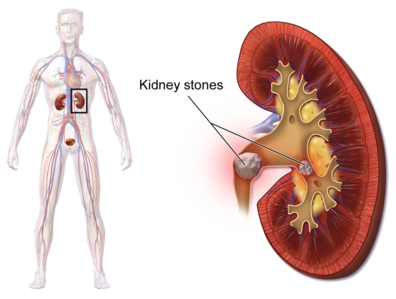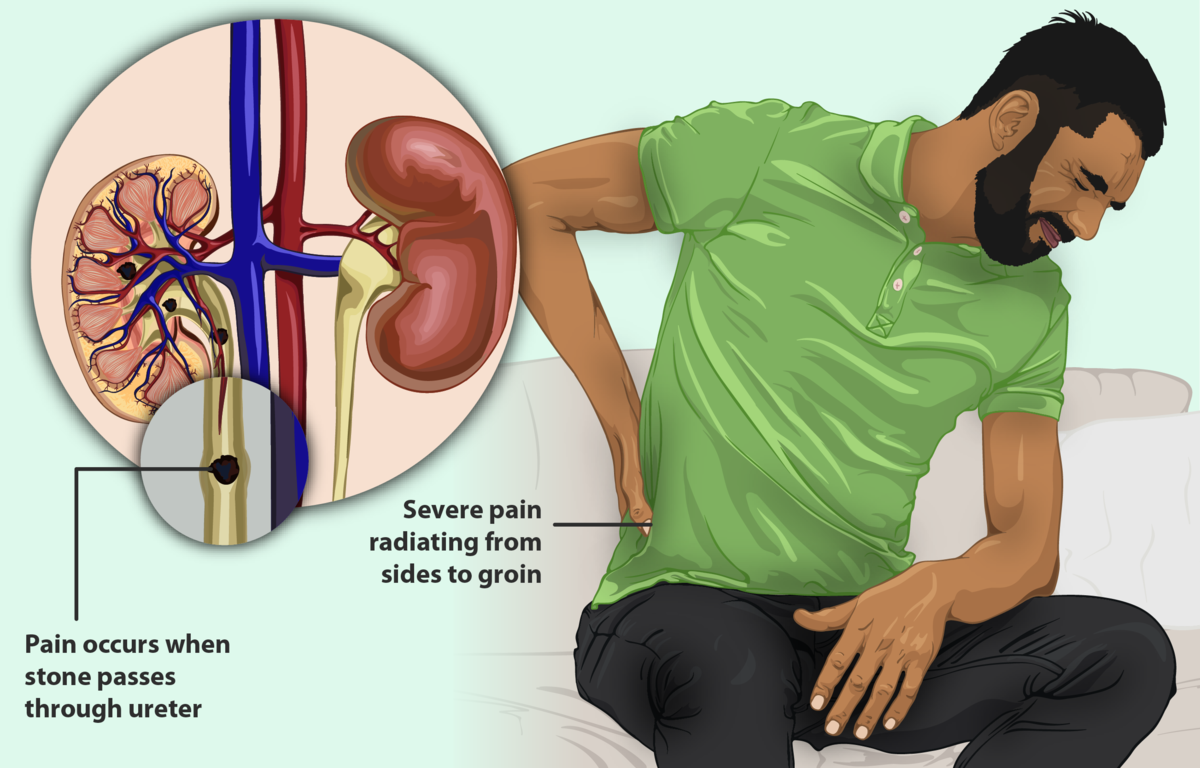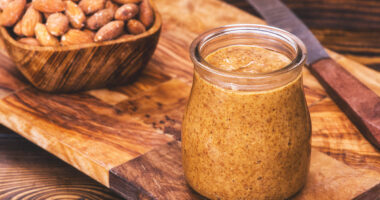Let’s find out ‘Does Lack Of Enzymes Causes Kidney Stones?’ For kidney stone issues, more than 500,000 patients visit emergency departments annually. One in ten people, according to estimates, will have kidney stones at some point in their life.
From 3.8% in the late 1970s to 8.8% in the late 2000s, kidney stones were more common in the US. In the years 2013–2014, kidney stones were 10% common. About 11% of men and 9% of women are at risk of developing kidney stones. Kidney stones are more likely to form in people who have additional illnesses like high blood pressure, diabetes, and obesity.
What Is A Kidney Stone?
A kidney stone is a solid item that is created from urine-based compounds. Kidney stones can be made of calcium oxalate, uric acid, struvite, or cystine. Shockwave lithotripsy, uteroscopy, percutaneous nephrolithomy, or nephrolithotripsy are all options for treating kidney stones. Severe lower back pain, blood in the urine, nausea, vomiting, a fever, chills, and bad-smelling or cloudy urine are all common symptoms.
Diverse wastes are dissolved in urine. Crystals start to develop when there is too much waste in too little liquid. The crystals draw in other substances and combine to produce a solid that will only grow unless it is eliminated from the body through urination. The kidney, the body’s chief chemist, often eliminates these compounds in the urine. Most people’s kidney stones are either washed out by enough liquid or prevented from forming by other chemicals in urine. Calcium, oxalate, urate, cystine, xanthine, and phosphate are the substances that cause stones to form.
The stone may remain in the kidney after it forms or it may move through the ureter and into the bladder. Sometimes, very small stones leave the body through the urine without causing too much discomfort. However, immobile stones can result in a urine backup in the kidney, ureter, bladder, or urethra. The pain is brought on by this.
What Are The Symptoms Of Kidney Stone?
Some kidney stones are the size of a sand grain. Some are the size of a pebble. A few of them are the size of golf balls! Generally speaking, the symptoms become more pronounced the larger the stone.

The symptoms could be one or more of the following:
- severe pain on either side of your lower back
- more vague pain or stomach ache that doesn’t go away
- blood in the urine
- nausea or vomiting
- fever and chills
- urine that smells bad or looks cloudy
When a kidney stone irritates or blocks the urinary tract, pain develops. Extreme pain is quickly intensified by this. Kidney stones often move through the body without harm, but generally not without excruciating agony. For tiny stones, pain medications could be the only thing required. Especially for stones that result in long-lasting symptoms or other complications, additional treatment may be required. Surgery, however, might be necessary in extreme cases.
What Are The Causes Of Kidney Stones?
Possible contributing factors include inadequate hydration, excessive or insufficient exercise, obesity, weight loss surgery, and a diet high in salt or sugar. For certain people, family history and infections may be significant. Consuming excessive amounts of fructose is associated with a higher risk of kidney stone formation. High fructose corn syrup and table sugar both contain fructose.
What Are Types Of Kidney Stones?
There Are Four Main Types Of Stones:
- Calcium Oxalate: the most typical kind of kidney stone, which is produced when calcium and oxalate combine in urine. Inadequate calcium and fluid intake, among other factors, may aid in their development.
- Uric Acid: This is yet another typical kidney stone kind. Foods rich in purines, a naturally occurring chemical component, include organ meats and shellfish. Increased monosodium urate production results from high purine intake, and under the right circumstances, this substance may form kidney stones. These kinds of stones frequently develop in families.
- Struvite: These less frequent stones are brought on by upper urinary tract infections.
- Cystine: These stones seem to run in families and are extremely uncommon.
Diagnosis
A medical history, physical examination, and imaging testing are the first steps in the diagnosis of a kidney stone. The precise size and shape of the kidney stones will be required by your specialists. This can be accomplished using a high resolution CT scan from the kidneys to the bladder or a KUB x-ray (kidney, ureter, and bladder x-ray), which will display the size and location of the stone. The surgeons frequently obtain a KUB x-ray to determine whether the stone can be treated with shock waves.
Although the CT scan is frequently favored for diagnosis, the KUB test may be utilized to monitor your stone both before and after therapy. A unique sort of X-ray of the urinary system called an intravenous pyelogram, or lVP, which is done after injecting a dye, may also be prescribed by doctors for some patients.
Second, the treatment for your stone will be decided by your doctors. Blood and urine tests will be used to assess the condition of your kidneys. We will take into account your overall health as well as the size and location of your stone.
Your doctor will later seek to determine what caused the stone. Your doctor will check your blood for calcium, phosphorus, and uric acid in addition to analyzing the stone once it has been removed from your body. In order to test for calcium and uric acid, the doctor might also ask you to keep track of your urine for 24 hours.
What Are The Treatment Required?
Kidney stones are treated similarly in adults and children. You could be instructed to consume a lot of water. Without doing surgery, doctors try to let the stone pass. You can also be prescribed medicine to lessen the acidity of your urine. However, surgery is required to remove it if it is too big, obstructs the passage of urine, or shows signs of infection.
With the help of high-intensity sound waves, the stones are broken up during the noninvasive technique known as shock-wave lithotripsy, making them easier to flow through the urine. In ureteroscopy, the stone is removed or destroyed by inserting an endoscope through the ureter. Rarely, doctors will use percutaneous nephrolithotomy/nephrolithotripsy for very large or complicated stones.
What You Should Do If You Have A Kidney Stone
As quickly as you can, visit a doctor. In an effort to remove the stone from the urine, you might be instructed to drink more liquids. If you strain your pee and can keep a fragment of the stone that has passed, bring it to your doctor. Or, surgery could be required to remove the stone.
Why Do Doctors Examine The Contents Of The Stone?
Four different kinds of stones exist. Investigating the stone can help you learn why you have it and how to lower your chances of developing further stones. Calcium is present in the most prevalent kind of stone. An everyday component of a balanced diet is calcium. Normally, surplus calcium that the body doesn’t need is removed by the kidney. People who have stones frequently retain too much calcium. A stone is created when this calcium combines with waste materials like oxalate. The most typical mixture is known as calcium oxalate.
Less frequent types of stones include struvite stones, which are caused by infections and contain magnesium and ammonia, and uric acid stones, which are made of monosodium urate crystals and may be caused by obesity and dietary factors. The most uncommon kind of stone is a cvstine stone, which frequently runs in families.
Consequences Explored
Chronic kidney disease is more likely to develop in people who have kidney stones. If you’ve already had one stone, your chances of getting another one are increased. A person who has had one stone is about 50% more likely to get another in the next five to seven years.
Kidney Stone Prevention
Getting adequate liquids will keep the concentration of waste materials in your urine from building up. If you are fully hydrated, your urine should be extremely light yellow to transparent since darker pee is more concentrated. Your primary fluid intake should be water. The average person needs to consume more than 12 glasses of water each day. Consult a healthcare practitioner to determine how much water is appropriate for you. Compared to soda, sports drinks, and coffee/tea, water is healthier. You should drink more if you exercise or if it’s hot outside. Small amounts of sugar and high-fructose corn syrup should be used.
Consume more fruits and vegetables to reduce the acidity of the urine. Stones may be less likely to develop when the urine is less acidic. Animal protein results in more acidic urine, which elevates your risk of kidney stones.

You can cut back on the extra salt you consume. What foods contain a lot of salt? French fries and salty potato chips come to mind for everyone. Rarely should they be consumed. Sandwich meats, canned soups, packaged dinners, and even sports drinks are examples of additional salty goods.
If you are overweight, you should endeavor to lose weight. Crash diets and high-protein weight-loss plans that contain a lot of animal protein, however, can increase the risk of stone development. You require enough protein, but it must be consumed as part of a healthy diet. When beginning a weight loss diet or any dietary interventions to lower the risk of kidney stones, seek advice from a registered dietitian.
Don’t be perplexed by your “calcium” stone. Dairy products contain calcium, but because calcium binds with oxalate before it enters the kidneys, they actually help prevent stones. Those who consume the least calcium through their diet are more likely to develop kidney stones. Potassium, protein byproducts, and salt all have the potential to turn into stones.
A calcium oxalate stone is the most typical kind of kidney stone. The majority of kidney stones are created when oxalate, a byproduct of several diets, binds to calcium while the kidneys are producing urine. When the body has too much salt and not enough water, both oxalate and calcium levels rise. Your doctor will decide which kinds of dietary changes are required in your unique situation based on blood and urine tests.
Some herbal remedies are marketed as aiding in stone prevention. You should be aware that there is insufficient medical research supporting the use of any supplement or herb to prevent stones.
If you’ve had a stone or believe your risk of getting one may be higher, talk to your doctor and/or a registered dietitian about changing your diet. They need to be aware of your dietary habits and medical history in order to guide you. The following are some possible queries:
- What food may cause a kidney stone?
- Should l take vitamin and mineral supplements?
- What beverages are good choices for me?










